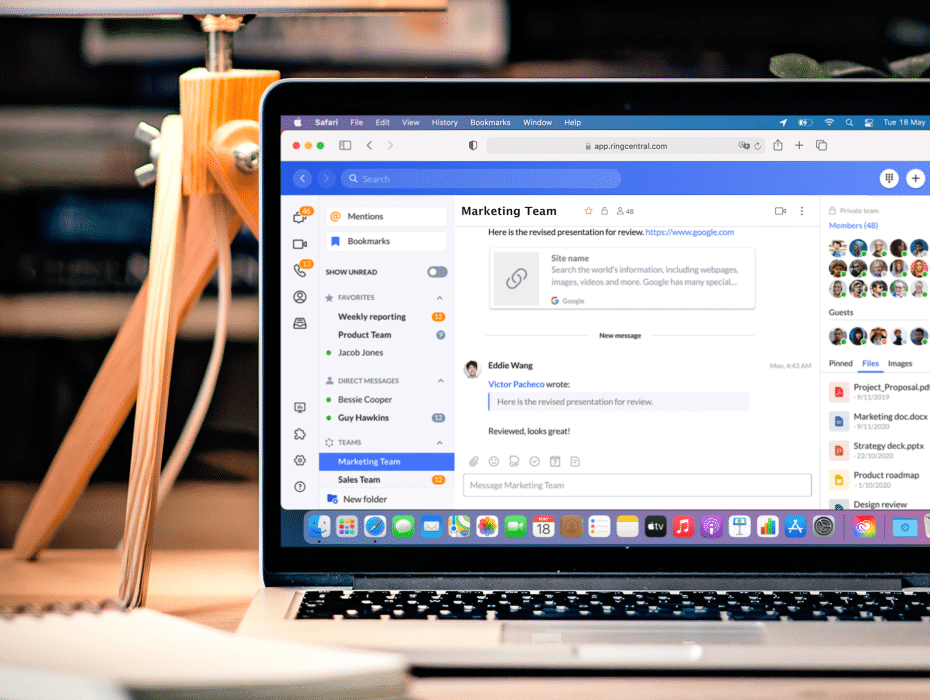If you’re wondering what work will look like after COVID-19, you aren’t alone. In early 2020, no one could’ve imagined the impact coronavirus would have around the globe. As the virus spread and new information emerged, we all learned together about the symptoms of COVID-19, like shortness of breath, coughing, and a loss of sense of smell. We discovered that the health risks were significant—the virus could lead to severe illness and death. Many businesses have had to implement protocols to comply with CDC guidance and adopt safety measures to protect the safety of their employees and customers.
Now for some good news: COVID-19 vaccines are being distributed to the global population. For many people, things are returning to normal. But the way we work is evolving, and COVID has only ignited the process. In the post-pandemic world, people want more flexibility. They want more control over their lives, including where and when they work.
So let’s look ahead to life after COVID, and how it’s impacted the world as we know it:

What changed for businesses during the pandemic?
The coronavirus caused a massive shake-up in the global and US workforce. Social distancing meant jobs had to be performed much differently. Others were scrapped entirely.
During the past year, many employees have been exposed to the risk of COVID-19 and been obliged to self-quarantine. The lucky ones were able to return to work after a negative COVID-19 test result. Others vulnerable to the disease were classified as high risk and were forced to shield themselves from the workplace indefinitely for their own well-being.
These uncertainties necessitated a shift towards remote work and the use of cloud communications apps that provide remote employees with the tools and features necessary to carry out their work effectively, like virtual collaboration and face-to-face interaction with HD audio and video.

Employees are less likely to leave… if they’re still employed
Businesses had to alter or even cease normal operations. Many workers around the world were either furloughed or lost their jobs.
The percentage of the workforce that quit their jobs has been rising steadily since 2011. Well, that was until we got to 2020! Growth had been humming along around 1.1% per year. But that all changed during the pandemic. In 2020, a drop of 3.7% in job leavers was observed. This is the lowest US employee turnover we’ve seen in five years!
A survey by Capterra revealed that 75% of workers are planning to stay at the job they have now. And 84% of employees say that the coronavirus pandemic made them like their job and employer about the same or more than they did pre-pandemic.
But for many who were laid off, extended unemployment has been a life saver: one they aren’t inclined to give up without an offer that pays well and offers better flexibility. As it stands in 2021, it’s a workers’ market when it comes to hiring.
Flexible work is here to stay
For essential workers, first responders, and those in care facilities, wearing protective suits, face masks, and other types of face coverings and other PPE became a part of their job, and it still is. But for many in office jobs, work was moved out of office. And because of social distancing restrictions, this meant work had to be done from home.

Remote working enabled businesses from all industries to maintain their services during the pandemic. Platforms like RingCentral MVP were behind this productivity, offering unified communications for their remote and onsite teams from anywhere on any device with minimal effort.
In a survey of small businesses, it was found that telework had jumped from 7% of the workforce to 30% during the pandemic.
And remote workers were also able to cut out commute time and transportation costs, with many businesses saving money on office space and energy bills.
Employees may also have been able to eliminate or reduce child care costs. And many found remote working conducive to a better work-life balance. As of June of 2020, 17% of employees wanted to continue flexible working permanently. But by January of this year, that number had already increased to 23%.
Nearly one in four employees of the US workforce would like to switch to remote work permanently! This means businesses will need to plan and adapt accordingly. Employers with remote teams can opt for a solution like RingCentral MVP, with messaging, video, and phone capabilities encompassed within one workspace. RingCentral also offers integrations with all your essential existing business processes, like your CRM, to avoid the need to toggle between apps and maintain workforce productivity and efficiency.
The future of work: Where do we go from here?
The pandemic has had a dramatic effect on every industry. Healthcare workers have been stretched thin while restaurants and cinemas were completely shut down for a time. The effects of lockdowns and COVID restrictions have not impacted all industries equally. A recent report from McKinsey measured the impact on labor and workforce skills.
The way we live and work is always evolving with technology. And the way businesses operate does the same. The pandemic saw us zoom through this evolution and re-shaped several trends in the global workforce.
Remote work and virtual meetings are the new normal
During the past 15 months, remote work and virtual meetings have become the norm. Companies have adopted apps like RingCentral Video to manage remote teams with free video meetings and built-in messaging.
And although we seem to be rounding the corner with the rollout of vaccinations, don’t expect these things just to disappear. According to the McKinsey report, 20 to 25% of the workforce in advanced economies could continue to work from home between three and five days a week post-pandemic without a loss of productivity.
This is four to five times more remote work than before the pandemic! It’s possible for some aspects of office work to lose effectiveness when conducted virtually. These activities include negotiations, critical business decisions, sensitive constructive criticism and feedback, and the onboarding of new employees.
But by harnessing the power of RingCentral’s features, you can prevent this. Its HD video conferencing is just like meeting face-to-face with employees and customers, so you can engage in critical negotiations with ease and provide considerate personal feedback. Screen sharing, file sharing, and call recording can expedite the onboarding process:
And, with its robust Analytics Portal, you’ll have access to an intuitive data layout and reports to make the best business decisions possible.
When it comes to travel and tourism, business travel looks to take a major dip. Companies are estimated to reduce travel by at least 20% post-pandemic. Instead, virtual meetings like video conferencing will help businesses save vast sums of money.
Even more eCommerce and virtual transactions
eCommerce has grown two to five times faster than before the pandemic. In the UK and US, eCommerce has seen a growth of 4.5 and 3.3%, respectively. But it’s more than just eCommerce that’s experienced accelerated growth.
Virtual transactions like telemedicine and online banking have become much more popular. Software solutions like RingCentral for telehealth have provided patients and care teams with a safe virtual point of contact. In addition to risk mitigation, platforms like RingCentral also help reduce costs, increase team collaboration, and help resolve patient issues quickly.
On the other side of the coin, entertainment streaming service demand grew too during the pandemic! People had to spend a lot more time at home, but virtual transactions met their wants and needs.
The shift to online shopping has demanded growth in areas like delivery, transportation, and warehousing of goods. This, of course, has created job growth for these industries. In China, more than 5.1 million jobs were created by eCommerce.
Increased reliance on automation
During the great disruption of operations, organizations were more likely to adopt new technology. Automation of routine tasks enabled businesses to reduce the workload required. In a survey of 800 senior executives, two-thirds stated they were increasing investment in automation and AI.
Automation and AI have been deployed in a range of industries. This includes warehouses, call centers, and manufacturing plants. Technology has enabled companies to reduce on-site employees—allowing them to focus instead on more judgment-oriented roles remotely—and handle peak hours or spikes in demand.
RingCentral’s IVR (interactive voice response) feature allows employees to offload simple customer queries and problems to AIs and spend more time providing solutions to issues that require more specialist advice and attention, thereby improving the customer experience. Customers don’t have to wait in long queues for a live agent, and agents’ lives are made much easier.
For many organizations, automation has been a necessary investment to stay afloat. And we can expect companies to continue to increase the use of automation and AI as tech evolves and their benefits become evident.
How will these changes impact small businesses?
COVID-19 has helped accelerate changing trends in work. But it’s also had an impact on job loss and growth. Industries like retail, sales, hospitality, and leisure have taken the brunt of jobs lost during the pandemic. Businesses will continue remote operations. And consumers will shop online more often. In a post-pandemic world, we can’t expect to see related occupations return to pre-pandemic levels.
COVID has initiated a major shift in the demand for services. Unfortunately, the pandemic has eliminated many low-wage jobs. But, at the same time, it’s creating different opportunities.
According to McKinsey, more than 100 million workers will need to find a different occupation by 2030. That means one out of 16 people will not be able to sustain their pre-pandemic occupation.
In the US, this need to shift occupations is 25% higher than before COVID. More than half of these workers will need new skills to make the job transition possible.
New skills required
In 2019, a survey by SHRM found that 75% of HR professionals reported difficulty in recruiting. And many attributed this to a skills shortage. Unfortunately, during the pandemic, skills development was put on the back burner for employers. Businesses were too busy struggling to stay out of the red and adapt to the impact COVID-19 had on their operations.
In a survey of small business employees, nearly half of employees didn’t develop any new skills during the pandemic. Of the half that did, about one-third developed new skills entirely on their own. This abandonment of employer-led skills development may have contributed to what is predicted to be a widening skills gap.
How to correct course and eliminate the skills gap
With the trends of remote work, growing eCommerce, and increased automation adoption, we need to plan for the future right now.
Today manual labor and basic admin tasks take up more than half of global work time. But the pandemic has demonstrated that this doesn’t need to be the case anymore. Automation and AI will reduce the job share of the routine and mundane. Software-as-a-service (SaaS) and other cloud solutions have made this technology adoption easy and affordable for any business.
And robotic automation for manufacturing, farming, and other types of production is already gaining momentum. By mid-2020, about halfway into the pandemic, China had already exceeded its prior production levels for robotics.
Accept and adapt
Businesses of all sizes, especially small businesses, must accept that the workforce of today and the future will desire flexible working conditions. More organizations are already moving to a four-day workweek or hybrid work model. The latter has proved to increase productivity for two-thirds of remote workers.
Coming out of the coronavirus pandemic, businesses will need to look at their employees as people, not numbers. Employee mental health will need to be prioritized. This means human resources will prove invaluable. Various programs can be put in place, but for many, flexible working will have a great impact.
And it’s up to each company to provide tools and training. This will encourage the adoption of tools like video conferencing and team messaging orr implementation of a unified communication as a service platform, productivity and collaboration tools, and other services. Solutions like a cloud PBX with RingCentral will allow your remote team to stay connected from anywhere and with any device… and save you money.

But remote work can come with its negatives. Time working out of the office is one thing, but companies should be wary of employee burnout. In some findings, working from home has increased total work hours. Companies should consider increasing benefits like sick leave and holiday entitlement.
Analyze and make a post-COVID plan
The decision-makers of each company should first take an in-depth look at remote work. What roles are suited to it? Which tasks can be executed remotely? Businesses should then look to shift at least a part of the workforce away from the office.
Once businesses have defined remote roles, it’s time to get the right person for the job. One way is to explore the actions of major players like Walmart, Amazon, and IBM. They’ve had great success focusing on skill-based recruiting to fill jobs— in place of academic degrees and qualifications.
Post-pandemic, workers will continue to migrate out of big cities and move to less populated areas. Both to enjoy some freedom and lower their cost of living. Companies with remote work models will be able to find all-star talent in unexpected places. And to get the most from that talent, companies should consider adopting a platform like RingCentral MVP to stay connected and manage remote teams effectively.
The post-pandemic workforce: Change is here
The workplace is changing and moving remote. Businesses need to look to the future. Flexible and remote work is here to stay. Find a solution like RingCentral MVP or RingCentral Video to start maximizing the potential of your workforce today.
Each organization should optimize the flexibility of work roles with automation technology. And crucially, businesses who evolve post-pandemic will be prepared for a future skills gap in the workforce. This will undoubtedly allow them to increase productivity, save money and time, and even improve their bottom line.
Looking For Startup Consultants ?
Call Pursho @ 0731-6725516
Telegram Group One Must Follow :
For Startups: https://t.me/daily_business_reads







